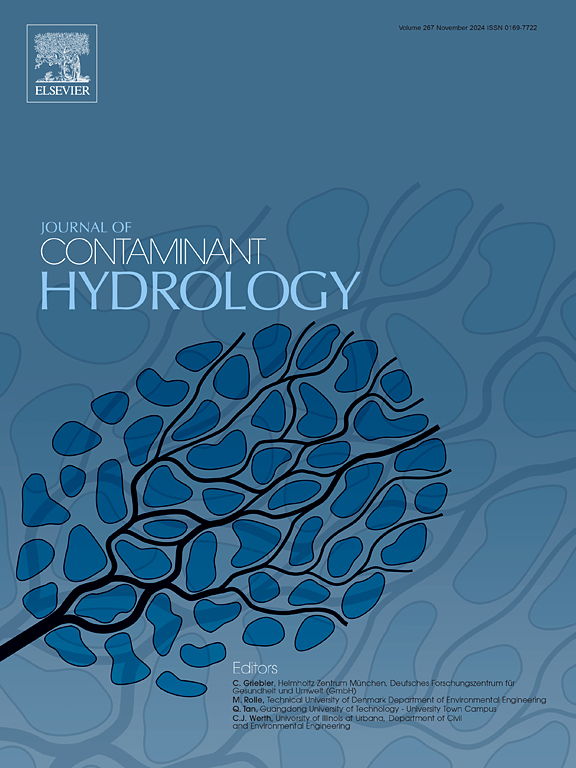盐污染物在渗透区上下循环的实验研究
IF 4.4
3区 环境科学与生态学
Q2 ENVIRONMENTAL SCIENCES
引用次数: 0
摘要
受污染的地下水在毛细管驱动下向上运动,随后的地表蒸发可导致渗透带的盐积累。相反,降雨或洪水等渗透事件可能使这些盐重新动员起来,并将它们向下输送到地下水位。虽然以前的研究经常孤立地处理这些过程,但对它们耦合行为的全面理解仍然有限。本研究采用三种颗粒状多孔介质:沙滩砂、硅砂和细砾石,对渗透带中的盐迁移率进行了受控的实验室研究。每个实验分为三个连续阶段,称为应力期:(1)毛细管将洁净水抽吸到干燥的多孔柱中,模拟地下水上升饱和;(2)蒸发引起的向上运移和盐结晶,海水取代了清洁的水,蒸发使地表附近的盐浓缩;(3)渗透水对盐的溶解和冲刷,模拟降雨事件对地表盐的再活化和浸出。在每次冲洗循环后测量出水中的盐浓度,以评估不同条件下的冲洗效率,包括不同的蒸发持续时间(短暂、中等和延长)和条件(自然蒸发与强制蒸发)。结果表明,砂层受浅层蒸发锋面影响,有利于表层地壳的形成,而砾石层则表现为地下盐沉积。由于孔隙较大,细粒砾石的初始冲刷速度更快,而细粒砂在表面附近保留了盐分,因此去除速度较慢,但更持久。强制蒸发通过形成致密的盐壳进一步阻碍了冲刷。这些发现为研究孔隙结构、颗粒大小和蒸发条件如何影响盐的保留和动员提供了新的见解。这些机制与受盐污染影响的干旱和半干旱地区有关,在这些地区,蒸发引起的盐积累和补给期间的冲刷之间发生了类似的循环。该研究为在洪水易发或干旱环境中改进地下水修复策略提供了信息。本文章由计算机程序翻译,如有差异,请以英文原文为准。
Experimental investigation of upward and downward cycling of salt contaminants in the vadose zone
Capillary-driven upward movement of contaminated groundwater and subsequent surface evaporation can lead to salt accumulation in the vadose zone. Conversely, infiltration events such as rainfall or flooding may remobilize these salts and transport them downward toward the water table. While previous studies have often addressed these processes in isolation, a comprehensive understanding of their coupled behavior remains limited.
This study presents a controlled laboratory investigation of salt mobility in the vadose zone using three types of granular porous media: beach sand, silica sand, and fine gravel. Each experiment was conducted in three sequential stages, referred to as stress periods: (1) capillary wicking of clean water into a dry porous column, simulating saturation by groundwater rise; (2) evaporation-induced upward transport and salt crystallization, where saltwater replaced the clean water and evaporation concentrated salts near the surface; and (3) dissolution and flushing of salts by infiltrating water, simulating rainfall events that remobilize and leach surface salts.
Salt concentrations in the effluent were measured after each flush cycle to assess the flushing efficiency under different conditions, including varying evaporation durations (brief, moderate, and extended) and conditions (natural vs. forced evaporation). Results showed that sands, due to shallow evaporation fronts, facilitated surface crust formation, while gravel exhibited subsurface salt deposition. Fine gravel achieved faster initial flushing due to larger pores, while finer sands retained salts near the surface, leading to slower but more sustained removal. Forced evaporation further impeded flushing by forming dense salt crusts.
The findings provide new insights into how pore structure, grain size, and evaporation conditions influence salt retention and mobilization. These mechanisms are relevant to sites like the arid and semi-arid regions affected by salt contamination, where similar cycling occurs between evaporation-induced salt accumulation and flushing during recharge. The study informs improved groundwater remediation strategies in flood-prone or arid environments.
求助全文
通过发布文献求助,成功后即可免费获取论文全文。
去求助
来源期刊

Journal of contaminant hydrology
环境科学-地球科学综合
CiteScore
6.80
自引率
2.80%
发文量
129
审稿时长
68 days
期刊介绍:
The Journal of Contaminant Hydrology is an international journal publishing scientific articles pertaining to the contamination of subsurface water resources. Emphasis is placed on investigations of the physical, chemical, and biological processes influencing the behavior and fate of organic and inorganic contaminants in the unsaturated (vadose) and saturated (groundwater) zones, as well as at groundwater-surface water interfaces. The ecological impacts of contaminants transported both from and to aquifers are of interest. Articles on contamination of surface water only, without a link to groundwater, are out of the scope. Broad latitude is allowed in identifying contaminants of interest, and include legacy and emerging pollutants, nutrients, nanoparticles, pathogenic microorganisms (e.g., bacteria, viruses, protozoa), microplastics, and various constituents associated with energy production (e.g., methane, carbon dioxide, hydrogen sulfide).
The journal''s scope embraces a wide range of topics including: experimental investigations of contaminant sorption, diffusion, transformation, volatilization and transport in the surface and subsurface; characterization of soil and aquifer properties only as they influence contaminant behavior; development and testing of mathematical models of contaminant behaviour; innovative techniques for restoration of contaminated sites; development of new tools or techniques for monitoring the extent of soil and groundwater contamination; transformation of contaminants in the hyporheic zone; effects of contaminants traversing the hyporheic zone on surface water and groundwater ecosystems; subsurface carbon sequestration and/or turnover; and migration of fluids associated with energy production into groundwater.
 求助内容:
求助内容: 应助结果提醒方式:
应助结果提醒方式:


